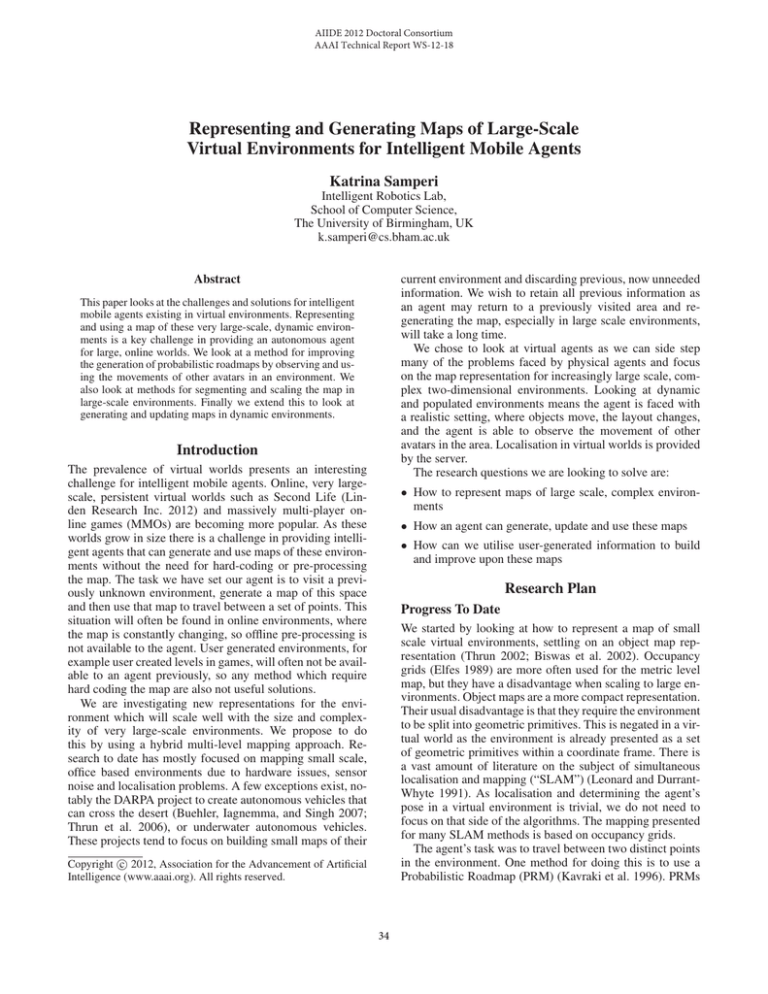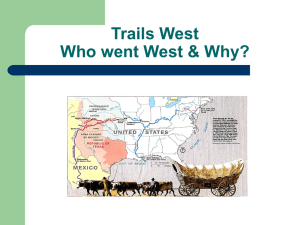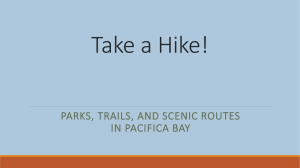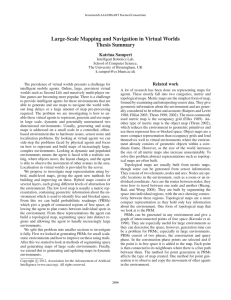Representing and Generating Maps of Large-Scale Katrina Samperi
advertisement

AIIDE 2012 Doctoral Consortium AAAI Technical Report WS-12-18 Representing and Generating Maps of Large-Scale Virtual Environments for Intelligent Mobile Agents Katrina Samperi Intelligent Robotics Lab, School of Computer Science, The University of Birmingham, UK k.samperi@cs.bham.ac.uk Abstract current environment and discarding previous, now unneeded information. We wish to retain all previous information as an agent may return to a previously visited area and regenerating the map, especially in large scale environments, will take a long time. We chose to look at virtual agents as we can side step many of the problems faced by physical agents and focus on the map representation for increasingly large scale, complex two-dimensional environments. Looking at dynamic and populated environments means the agent is faced with a realistic setting, where objects move, the layout changes, and the agent is able to observe the movement of other avatars in the area. Localisation in virtual worlds is provided by the server. The research questions we are looking to solve are: This paper looks at the challenges and solutions for intelligent mobile agents existing in virtual environments. Representing and using a map of these very large-scale, dynamic environments is a key challenge in providing an autonomous agent for large, online worlds. We look at a method for improving the generation of probabilistic roadmaps by observing and using the movements of other avatars in an environment. We also look at methods for segmenting and scaling the map in large-scale environments. Finally we extend this to look at generating and updating maps in dynamic environments. Introduction The prevalence of virtual worlds presents an interesting challenge for intelligent mobile agents. Online, very largescale, persistent virtual worlds such as Second Life (Linden Research Inc. 2012) and massively multi-player online games (MMOs) are becoming more popular. As these worlds grow in size there is a challenge in providing intelligent agents that can generate and use maps of these environments without the need for hard-coding or pre-processing the map. The task we have set our agent is to visit a previously unknown environment, generate a map of this space and then use that map to travel between a set of points. This situation will often be found in online environments, where the map is constantly changing, so offline pre-processing is not available to the agent. User generated environments, for example user created levels in games, will often not be available to an agent previously, so any method which require hard coding the map are also not useful solutions. We are investigating new representations for the environment which will scale well with the size and complexity of very large-scale environments. We propose to do this by using a hybrid multi-level mapping approach. Research to date has mostly focused on mapping small scale, office based environments due to hardware issues, sensor noise and localisation problems. A few exceptions exist, notably the DARPA project to create autonomous vehicles that can cross the desert (Buehler, Iagnemma, and Singh 2007; Thrun et al. 2006), or underwater autonomous vehicles. These projects tend to focus on building small maps of their • How to represent maps of large scale, complex environments • How an agent can generate, update and use these maps • How can we utilise user-generated information to build and improve upon these maps Research Plan Progress To Date We started by looking at how to represent a map of small scale virtual environments, settling on an object map representation (Thrun 2002; Biswas et al. 2002). Occupancy grids (Elfes 1989) are more often used for the metric level map, but they have a disadvantage when scaling to large environments. Object maps are a more compact representation. Their usual disadvantage is that they require the environment to be split into geometric primitives. This is negated in a virtual world as the environment is already presented as a set of geometric primitives within a coordinate frame. There is a vast amount of literature on the subject of simultaneous localisation and mapping (“SLAM”) (Leonard and DurrantWhyte 1991). As localisation and determining the agent’s pose in a virtual environment is trivial, we do not need to focus on that side of the algorithms. The mapping presented for many SLAM methods is based on occupancy grids. The agent’s task was to travel between two distinct points in the environment. One method for doing this is to use a Probabilistic Roadmap (PRM) (Kavraki et al. 1996). PRMs c 2012, Association for the Advancement of Artificial Copyright Intelligence (www.aaai.org). All rights reserved. 34 tions the new point would have. If it has a very large number of neighbours then this point is not considered to add new information and so is discarded. However, it is still important to preserve the links between points in a single trail when discarding the point. We also want to investigate further how trails can be used to predict the structure of the environment. This will be especially useful for the next section of research we are focusing on, how to segment maps intelligently in large scale environments. can be built for any type of environment and consist of a set of points in free space and a set of arcs, describing the connections and possibility of moving between points. The disadvantage of PRMs is that they can take a very long time to generate. Also, in environments with narrow passages generating a map that can connect all sections of the environment can be a hard problem. This type of environment relies on the correct set of points being selected for inclusion in the exact right places in the environment to connect all sections. Our hypothesis was that we could observe and use the movement of other avatars in the environment to help solve this problem. We refer to the list of points where an avatar has been observed over time as a trail. Trails are formed when an agent (human, animal or vehicle) moves from one place to another, leaving some evidence of their movement. Trails in the real world have been used by people for centuries to learn how to navigate new environments over time. Trails have also been used to help humans navigate through virtual environments (Ruddle 2005) and given robots a starting point for building maps (Yuan, Twardon, and Hanheide 2010). More recently, some work has been done extending SLAM to identify moving objects in an environment (“SLAMMOT”) (Chung and Huang 2008). This looks at how the structure of an environment can be predicted by looking at the movement of objects and other agents around that environment. Digital trails are based on observations of the movements of other agents in a virtual environment. We can use these trails to discover the paths between areas in an environment. We defined a good roadmap as one that is able to successfully plan routes, while keeping the length of those routes as short as possible. The map should also be generated in a short amount of time. We ran a series of experiments that compared PRMs generated using a variety of point selection methods. In each case we measured the generation time, the success rate of planning routes and the length of the subsequent route. We found that the combination of trail points with other methods (in this case, Gaussian (Boor, Overmars, and van der Stappen 1999) and Halton (Geraerts and Overmars 2002) point selection) generated maps which were highly successful at finding routes. Trail based maps also generated some of the shortest routes. However, the generation time for trail based maps far exceeded other point selection methods. We believe this is due to the nature of trail points. As they are gathered by observing the movements of other agents in the environment then we must consider the motives of those agents. When in a virtual world not all avatars move directly from one place to another, they linger in places observing their surroundings or socialising, all the time making very small movements. These register a very large number of trail points within a small area of the environment, adding points to the map but no new or useful information, and slowing down the addition of other points. We are currently working on a method of reducing the generating time by classifying and selecting trail points based on the amount of new information they add to the roadmap. When each point is selected for inclusion in the roadmap we look at the number of neighbours and connec- Next Steps Segmenting the map for large scale environments Over the summer we will be looking at how to represent and build maps of very large scale environments. This builds on our previous work by extracting a topological map from the underlying metric representation. Topological maps are an abstract form of map which segments the environment into smaller sections. It is important that the map is segmented intelligently, such that related sections of the environment are kept together. If this is not done then building and the upkeep of the map in dynamic environments will require more time and processing. Ideally, if the map requires updating, all changes should be confined to a single region and its neighbours. There are numerous methods for segmenting maps, the best of which take into account the structure of the environment. We will look at comparing quadtree (Finkel and Bentley 1974) and regular segmentation with methods such as Delaunay (Lee and Schachter 1980) and Voronoi segmentation (Thrun 2002). We can also use trail points to influence the segmentation. By observing trails forming in the environment we can identify cluster points in the map. These are areas where a lot of avatars have gathered or passed through. We can identify related areas of the environment by looking at the most commonly linked places over time (for example, the central ‘start’ point of the environment and the main social hub). Our map representation will then comprise three levels and the following information: 1) The topological map, giving a high level abstraction of the space, 2) an object map within each node and 3) a PRM. We hypothesise that this map representation will allow the agent to build maps of very large scale environments, reducing the time required to maintain the map and plan routes within it. Updating the map in dynamic environments Until now the agent has been given all the object and trail information upfront to build maps from. However, this will not always be the case. We are interested in building large scale maps of previously unknown environments, where the agent will have to explore and build the map incrementally. Interesting questions arise here about how to segment the environment when the agent does not have the full information and how to change the segmentation when more information is known. The agent will be including trail information as it is gathered, rather than relying on it to build a single PRM at the start and then plan using this. Identifying cluster points and adapting the topological map to represent these connected regions will be important. 35 References This also applies to updating the map in dynamic environments. The construction cost of changing virtual worlds is low, so they tend to change rapidly and without warning. This will require the agent to update its map and recognise whether a change is temporary or not. We will need to adapt and change the underlying PRMs used to plan routes as the environment changes. With the right segmentation method however this change should be confined to a few segments rather than the entire environment. One aspect we are interested in looking at is how to use the knowledge gained from generating maps of previous environments to build a better starting map of an unknown environment. If the agent it able to identify trends in the way a world is put together then there will be less of a need to change how topological segmentation is performed. Biswas, R.; Limketkai, B.; Sanner, S.; and Thrun, S. 2002. Towards object mapping in non-stationary environments with mobile robots. Boor, V.; Overmars, M.; and van der Stappen, A. 1999. The gaussian sampling strategy for probabilistic roadmap planners. Proc. Robotics and Automation, IEEE International Conference on 2:1018 –1023. Buehler, M.; Iagnemma, K.; and Singh, S., eds. 2007. The 2005 DARPA Grand Challenge: The Great Robot Race (Springer Tracts in Advanced Robotics), volume 36. Chung, S. Y., and Huang, H. P. 2008. Simultaneous topological map prediction and moving object trajectory prediction in unknown environments. Proc. IEEE/RSJ Int. Conf. on Intelligent Robots and Systems 1594–1599. Nice, France. Elfes, A. 1989. Using occupancy grids for mobile robot perception and navigation. Computer 22(6):46–57. Finkel, R., and Bentley, J. 1974. Quad trees a data structure for retrieval on composite keys. Acta informatica 4(1):1–9. Geraerts, R., and Overmars, M. H. 2002. A comparative study of probabilistic roadmap planners. In Workshop on the algorithmic foundations of robotics, 43–57. Kavraki, L.; Svestka, P.; Latombe, J.-C.; and Overmars, M. 1996. Probabilistic roadmaps for path planning in highdimensional configuration spaces. IEEE Transactions on Robotics and Automation 12(4):566–580. Lee, D. T., and Schachter, B. J. 1980. Two algorithms for constructing a delaunay triangulation. International Journal of Computer and Information Sciences 9(3):219–242. Leonard, J., and Durrant-Whyte, H. 1991. Simultaneous map building and localization for an autonomous mobile robot. In Intelligent Robots and Systems ’91. ’Intelligence for Mechanical Systems, Proceedings IROS ’91. IEEE/RSJ International Workshop on, 1442 –1447 vol.3. Linden Research Inc. 2012. Second life official site. http: //secondlife.com. [Last accessed: 01/2012]. Ruddle, R. 2005. The effect of trails on first-time and subsequent navigation in a virtual environment. In VR ’05: Proceedings of the 2005 IEEE Conference 2005 on Virtual Reality, 115–122, 321. IEEE Computer Society. Thrun, S.; Montemerlo, M.; Dahlkamp, H.; Stavens, D.; Aron, A.; Diebel, J.; Fong, P.; Gale, J.; Halpenny, M.; Hoffmann, G.; Lau, K.; Oakley, C.; Palatucci, M.; Pratt, V.; Stang, P.; Strohband, S.; Dupont, C.; Jendrossek, L.-E.; Koelen, C.; Markey, C.; Rummel, C.; van Niekerk, J.; Jensen, E.; Alessandrini, P.; Bradski, G.; Davies, B.; Ettinger, S.; Kaehler, A.; Nefian, A.; and Mahoney, P. 2006. Stanley: The robot that won the darpa grand challenge: Research articles. J. Robot. Syst. 23:661–692. Thrun, S. 2002. Robotic mapping: A survey. In Lakemeyer, G., and Nebel, B., eds., Exploring Artificial Intelligence in the New Millenium. Morgan Kaufmann. Yuan, F.; Twardon, L.; and Hanheide, M. 2010. Dynamic path planning adopting human navigation strategies for a domestic mobile robot. In Intelligent Robots and Systems, 3275–3281. Conclusion This summary has looked at how an intelligent mobile virtual agent can represent, build and use map of large-scale, unknown and dynamic environments. In particular we are looking at how trails, the movements of others in these environments, can be used to identify routes and popular locations in the environment. The anticipated contributions of this thesis are 1. A new method for representing, generating, updating and using maps of large scale, dynamic environments 2. A method for improving the generation of probabilistic roadmaps using trails 3. A method for segmenting space intelligently in large scale environments using trails 4. A full review and analysis of the literature related to map representation in large scale environments Timetable This section covers a brief time table of my expected future activities: • May: Reducing the generation time for trail-based PRMs • June-August: Representing maps of large scale environments: segmenting the space and generating topological representations for large scale environments • September: Writing up the results for segmentation work • October-November: Dynamism in maps: Generating the map and updating it over time • November-December: Start writing thesis, have an outline for each section • January-February 2013: Introduction and Literature Review • March: Improving Probabilistic Roadmaps using trails • April: Segmenting the environment for large scale maps • May: Building and updating dynamic large scale maps • June: Conclusion • June - August: Proof reading and submission of thesis 36





